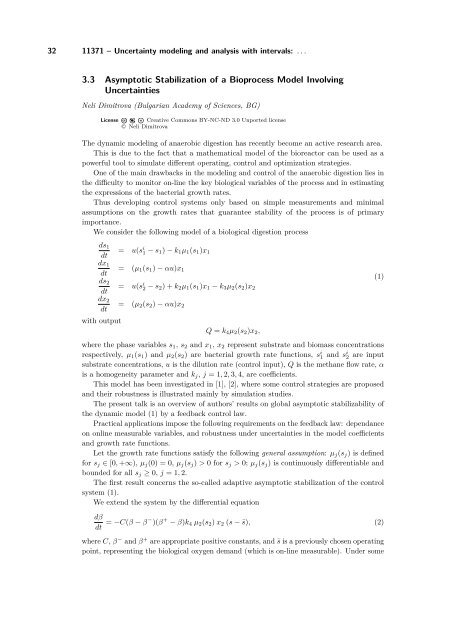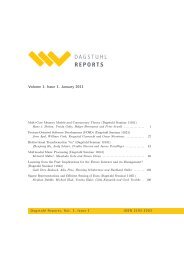Uncertainty modeling and analysis with intervals - DROPS - Schloss ...
Uncertainty modeling and analysis with intervals - DROPS - Schloss ...
Uncertainty modeling and analysis with intervals - DROPS - Schloss ...
Create successful ePaper yourself
Turn your PDF publications into a flip-book with our unique Google optimized e-Paper software.
32 11371 – <strong>Uncertainty</strong> <strong>modeling</strong> <strong>and</strong> <strong>analysis</strong> <strong>with</strong> <strong>intervals</strong>: . . .<br />
3.3 Asymptotic Stabilization of a Bioprocess Model Involving<br />
Uncertainties<br />
Neli Dimitrova (Bulgarian Academy of Sciences, BG)<br />
License Creative Commons BY-NC-ND 3.0 Unported license<br />
© Neli Dimitrova<br />
The dynamic <strong>modeling</strong> of anaerobic digestion has recently become an active research area.<br />
This is due to the fact that a mathematical model of the bioreactor can be used as a<br />
powerful tool to simulate different operating, control <strong>and</strong> optimization strategies.<br />
One of the main drawbacks in the <strong>modeling</strong> <strong>and</strong> control of the anaerobic digestion lies in<br />
the difficulty to monitor on-line the key biological variables of the process <strong>and</strong> in estimating<br />
the expressions of the bacterial growth rates.<br />
Thus developing control systems only based on simple measurements <strong>and</strong> minimal<br />
assumptions on the growth rates that guarantee stability of the process is of primary<br />
importance.<br />
We consider the following model of a biological digestion process<br />
ds1<br />
dt = u(si 1 − s1) − k1µ1(s1)x1<br />
dx1<br />
dt = (µ1(s1) − αu)x1<br />
ds2<br />
dt = u(si 2 − s2) + k2µ1(s1)x1 − k3µ2(s2)x2<br />
dx2<br />
dt = (µ2(s2) − αu)x2<br />
<strong>with</strong> output<br />
Q = k4µ2(s2)x2,<br />
where the phase variables s1, s2 <strong>and</strong> x1, x2 represent substrate <strong>and</strong> biomass concentrations<br />
respectively, µ1(s1) <strong>and</strong> µ2(s2) are bacterial growth rate functions, s i 1 <strong>and</strong> s i 2 are input<br />
substrate concentrations, u is the dilution rate (control input), Q is the methane flow rate, α<br />
is a homogeneity parameter <strong>and</strong> kj, j = 1, 2, 3, 4, are coefficients.<br />
This model has been investigated in [1], [2], where some control strategies are proposed<br />
<strong>and</strong> their robustness is illustrated mainly by simulation studies.<br />
The present talk is an overview of authors’ results on global asymptotic stabilizability of<br />
the dynamic model (1) by a feedback control law.<br />
Practical applications impose the following requirements on the feedback law: dependance<br />
on online measurable variables, <strong>and</strong> robustness under uncertainties in the model coefficients<br />
<strong>and</strong> growth rate functions.<br />
Let the growth rate functions satisfy the following general assumption: µj(sj) is defined<br />
for sj ∈ [0, +∞), µj(0) = 0, µj(sj) > 0 for sj > 0; µj(sj) is continuously differentiable <strong>and</strong><br />
bounded for all sj ≥ 0, j = 1, 2.<br />
The first result concerns the so-called adaptive asymptotic stabilization of the control<br />
system (1).<br />
We extend the system by the differential equation<br />
dβ<br />
dt = −C(β − β− )(β + − β)k4 µ2(s2) x2 (s − ¯s), (2)<br />
where C, β − <strong>and</strong> β + are appropriate positive constants, <strong>and</strong> ¯s is a previously chosen operating<br />
point, representing the biological oxygen dem<strong>and</strong> (which is on-line measurable). Under some<br />
(1)













